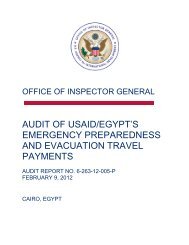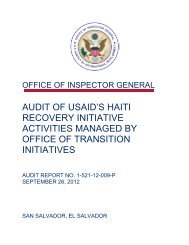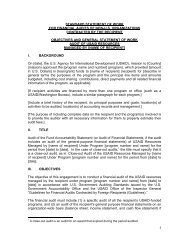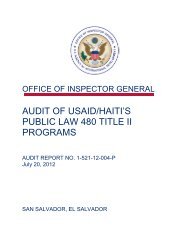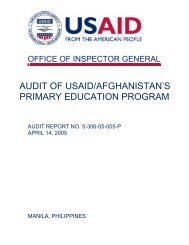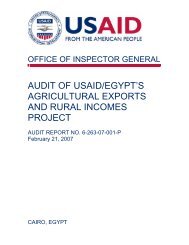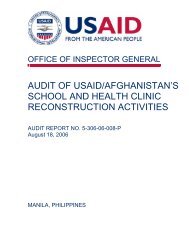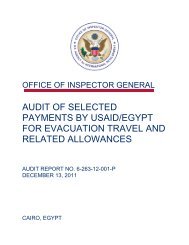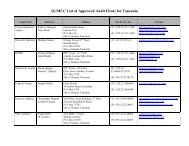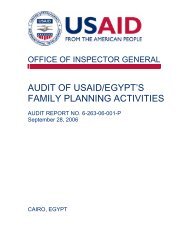USAID OIG Afghanistan and Pakistan Oversight Report, April-June ...
USAID OIG Afghanistan and Pakistan Oversight Report, April-June ...
USAID OIG Afghanistan and Pakistan Oversight Report, April-June ...
- No tags were found...
You also want an ePaper? Increase the reach of your titles
YUMPU automatically turns print PDFs into web optimized ePapers that Google loves.
establishing a distribution policy, PPAF gave priority to households that had not received any aid from otherdonors.Auditors observed that PPAF teams followed the organization’s distribution policy. First, the teamresponsible for distribution of the relief items matched recipients’ tokens <strong>and</strong> <strong>Pakistan</strong>i national identitycards to recipients’ names on the master token distribution list. Second, the team directed recipients to acounter where they exchanged their tokens for food hampers <strong>and</strong> hygiene kits. Lastly, the team collectedrecipients’ signatures or thumb impressions to record the transaction.Audit of <strong>USAID</strong>/<strong>Pakistan</strong>’s Livelihood Development Program for the Upper Region of the FederallyAdministered Tribal Areas (<strong>Report</strong> No. G-391-11-002-P, December 10, 2010)FATA has high unemployment, widespread poverty, <strong>and</strong> separate legal structures. Located in northwestern<strong>Pakistan</strong>, FATA shares its rugged <strong>and</strong> mountainous border with <strong>Afghanistan</strong>. Extremist <strong>and</strong> terrorist groupstake advantage of the geographic <strong>and</strong> social isolation <strong>and</strong> lack of governing systems to exert their influenceon the people of this region. Development in FATA has become vital to <strong>Pakistan</strong>’s progress in fightinginsurgents.The main goal of the Livelihood Development Program is to provide social <strong>and</strong> economic stabilization inFATA to counter the growing influence of extremist groups. The program has three components: 1) creatingjobs, increasing incomes, <strong>and</strong> teaching employable skills with a focus on unemployed youth, 2) revitalizingcommunity infrastructure <strong>and</strong> essential services, <strong>and</strong> 3) supporting established businesses <strong>and</strong> developingnew sustainable businesses.After a review of the first 2 years of activities, <strong>OIG</strong> found that the program has not achieved its main goal ofsocial <strong>and</strong> economic stabilization to counter the growing influence of extremist <strong>and</strong> terrorist groups inupper FATA. The mission had no baseline data to determine progress toward countering the influence ofthese groups. In addition, the program had executed only 53 percent of planned activities, <strong>and</strong> programoutcomes were weak.Security issues were the main cause of the delays <strong>and</strong> poor performance. Specific incidents included theassassination of the chief of party for the implementer working in lower FATA, the kidnapping of an aidworker, <strong>and</strong> threats to monitoring teams. Allegations of wrongdoing also impeded progress. Theimplementer stated that program activities were delayed because the implementer had to counter theseallegations <strong>and</strong> because of additional tiers of oversight put in place to ensure greater accountability.Moreover, program activities stopped for 6 months until security measures were improved <strong>and</strong> a new chiefof party was appointed.Two additional factors contributed to program delays. First, <strong>USAID</strong>/<strong>Pakistan</strong> used program resources toprovide humanitarian <strong>and</strong> disaster assistance to flood victims <strong>and</strong> internally displaced persons fleeingconflict areas of FATA. The assistance began in August 2008, only months after the upper FATA programstarted, <strong>and</strong> continued until the implementer’s termination. Mission officials acknowledged that the workdiverted time <strong>and</strong> resources from Livelihood Development Program activities. Second, in September 2009the U.S. Department of State (State Department) initiated a shift in strategy toward using more <strong>Pakistan</strong>iinstitutions to implement <strong>USAID</strong> programs. During this time, all <strong>USAID</strong>/<strong>Pakistan</strong> incremental funding92 <strong>USAID</strong> <strong>OIG</strong> <strong>Afghanistan</strong> <strong>and</strong> <strong>Pakistan</strong> <strong>Oversight</strong> <strong>Report</strong>



